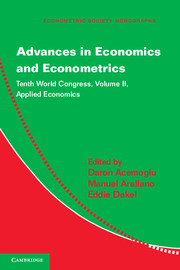Book contents
- Frontmatter
- Contents
- Contributors
- Preface
- I FINANCE
- II POLITICAL ECONOMY
- III MACROECONOMICS
- IV TRADE AND FIRM DYNAMICS
- 7 Trade Liberalization and Firm Dynamics
- 8 International Trade: Linking Micro and Macro
- V GROWTH
- VI FRISCH LECTURE
- VII PERSPECTIVES ON CHINESE ECONOMIC GROWTH
- Name Index
- Miscellaneous Endmatter
8 - International Trade: Linking Micro and Macro
Published online by Cambridge University Press: 05 May 2013
- Frontmatter
- Contents
- Contributors
- Preface
- I FINANCE
- II POLITICAL ECONOMY
- III MACROECONOMICS
- IV TRADE AND FIRM DYNAMICS
- 7 Trade Liberalization and Firm Dynamics
- 8 International Trade: Linking Micro and Macro
- V GROWTH
- VI FRISCH LECTURE
- VII PERSPECTIVES ON CHINESE ECONOMIC GROWTH
- Name Index
- Miscellaneous Endmatter
Summary
Introduction
The field of international trade has advanced in the past decade through a healthy exchange between new observations on firms in export markets and new theories that have introduced producer heterogeneity into trade models. As a result, we now have general equilibrium theories of trade that are consistent with various dimensions of both the aggregate and the firmlevel data. Furthermore, we have a much better sense of the magnitudes of key parameters underlying these theories.
This flurry of activity at the firm level has left the core aggregate relationships among trade, factor costs, and welfare largely untouched, however. Although we now have much better microfoundations for aggregate trade models, their predictions aremuch like those of the Armington model – for years a workhorse of quantitative international trade. Arkolakis, Costinot, and Rodríguez-Clare (2012) emphasized this (lack of) implication of the recent literature for aggregate trade.
We argue that a primary reason why models of heterogeneous producers deliver so little in the way of modification of how we think about aggregates is the device – initiated in the trade literature by Dornbusch, Fischer, and Samuelson (1977) – of treating the set of products as a continuum.
- Type
- Chapter
- Information
- Advances in Economics and EconometricsTenth World Congress, pp. 329 - 370Publisher: Cambridge University PressPrint publication year: 2013
- 16
- Cited by



